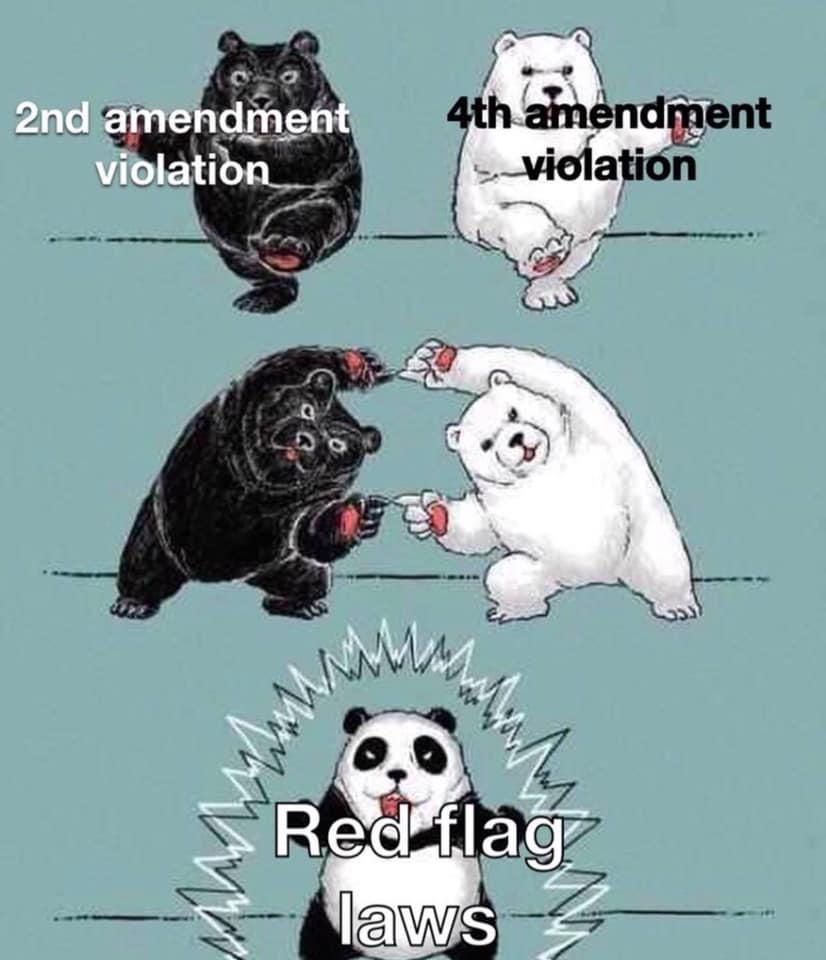We’ve talked about MTS before, but for review Magic Talisman Syndrome is where someone believes possession or ownership of a thing confers an automatic benefit. In most cases we’re referring to the gun owner who buys the gun and just enough ammunition to fill a magazine, perhaps never fires it, and tosses it into the proverbial sock drawer, “just in case.”
However anti-gunners have their own magic talismans, and the favorite at the moment is the ‘Red Flag’ 🚩.
Reason has a good piece on why you should curb your enthusiasm on these rules and their alleged benefits.
Advertisement — Continue Reading Below
The mass shooting at an Independence Day parade in Highland Park, Illinois, poses a familiar question: Why didn’t the state’s “red flag” law, which is designed to disarm people who are deemed a threat to themselves or others, prevent the perpetrator from buying the rifle he used in the attack? The gun control law that Congress passed in response to recent mass shootings raises another question: Would its provisions have made any difference in this case?
Crimo III had a previous suicide attempt and weapons confiscated from his property in 2019, but he was not Red Flagged by any of the authorities he officially interacted with for criminal or psychological reasons. He is the proverbial individual that Red Flag and ERPO laws are supposed to address, yet they could not build the case for him in Illinois at the time and he later went on to commit an atrocity.
Did the system fail because it was improperly built or are we putting our hopes into a program that cannot succeed under any parameters? Is this outside our control and we are grasping for a magic shield that does not and cannot exist?
Advertisement — Continue Reading Below
The answers to those questions underline the limitations of laws that aim to prevent this sort of crime by restricting access to firearms. Gun controls that look sensible in theory frequently fail in practice, either because they are ill-suited to prevent mass shootings, do not apply, or were not enforced. That does not mean such laws have no effect on violent crime. But it does mean that Americans should be skeptical when politicians tout the lifesaving potential of a particular policy, especially when it also has the potential to deprive innocent people of their constitutional rights.
Medicine worse than they symptom, but again gun controllers never layout the expected negative outcomes of their policies when they propose them. They don’t give things like expected false positive rates, number of innocent people falsely accused, amount of taxpayer money wasted, reputations ruined, lives upended, or any of those estimates. They simply tout the thing they wish will happen if this policy is implemented and all goes right.
Nothing. Ever. Goes. Right.
Advertisement — Continue Reading Below
Not when we’re talking about changes and events on this scale. We aren’t talking about putting the proper amount of peanut butter on a single sandwich, we’re talking about serving everyone a peanut butter sandwich and with 100% accuracy missing all the peanut allergies.
The New York Times notes that the 21-year-old man who prosecutors say admitted to murdering seven people and injuring dozens of others in Highland Park on Monday “was known to police” because of two incidents in 2019. In April 2019, Reuters reports, police visited his Highland Park home in response to a 911 caller who said he “had attempted suicide.” That September, police returned in response to “alleged threats ‘to kill everyone’ that he had directed at family members.”
During the second visit, police asked the young man if he was suicidal, which he denied. They “seized a collection of 16 knives, a dagger and a sword” that belonged to the 18-year-old’s father, which they later returned to him.
Advertisement — Continue Reading Below
Police did not arrest the son because they lacked probable cause to believe he had committed a crime. “There were no complaints that were signed by any of the victims,” Chris Covelli, a sergeant with the Lake County Sheriff’s Office, told reporters yesterday. But Highland Park police reported the incident to the Illinois State Police, which took no action.
So those involved, both officially as arbiters of public health and law, and those who were ‘victims’ or otherwise connected to the incident did not make this into an issue beyond notation of the event. It therefore did not flag into NICS or the Illinois state system as worthy of denying Crimo III his right to a firearm in the future. He then got his FOID and purchased firearms in 2020 and 2021. He then attacked a parade, killing 7, in 2022.
How did that happen?
Advertisement — Continue Reading Below
State police offered two explanations for that. First, the future mass murderer at that point did not have a firearm owners identification card (FOID), which is required to legally buy or own guns in Illinois, and had not applied for one. Second, Reuters reports, state police “said no relative or anyone else was willing ‘to move forward with a formal complaint’ or to provide ‘information on threats or mental health that would have allowed law enforcement to take additional action.'”
So he did not have a FOID at the time and his family gave him benefit of the doubt, which is rather normal for family even if unwise. Family social dynamics are a whole complexity unto themselves.
The state’s red flag law, which took effect at the beginning of 2019, authorizes police as well as family members to seek a “firearms restraining order” that bars the respondent from purchasing or possessing guns. But if the future killer’s relatives were uncooperative, collecting evidence to support a petition would have been difficult, since the case hinged on their account of his words and actions.
Advertisement — Continue Reading Below
So like the problems with any domestic violence case where those close to it choose the, “It wasn’t really that bad…” mode of incident reporting and do not want to ruin the future of the alleged assailant, it gets complicated.
Like the other states with red flag laws, Illinois gives people who are concerned that someone poses a danger two options. They can obtain an “emergency” order, which is issued without a hearing or notice, if a judge decides there is “probable cause to believe that the respondent poses an immediate and present danger of causing personal injury to himself, herself, or another.” Such ex parte orders last up to two weeks, at which point the respondent actually gets a chance to respond.
Alternatively, or when an ex parte order is about to expire, a petitioner can seek a six-month order, which requires a hearing. The standard at that point is “clear and convincing evidence” that the respondent poses “a significant danger…in the near future.” If an order is issued, it can be renewed for another six months based on a showing that the respondent continues to pose a significant danger.
Advertisement — Continue Reading Below
Here’s the brutally simple problem of it all, human beings are capable of two incredibly difficult things to work around, lying and changing their mind. A person, of their own free will, is able to deceive or change what they were going to do at will. This requires other people to try and speculate accurately on whether or not a person will do something needing intervention at some indeterminate point in the future without violating their civil rights, because there is no cause to.
The evidence that a judge is required to consider includes “threats of violence or acts of violence by the respondent directed toward himself, herself, or another.” That certainly seems relevant in this case. But again, police would have had a hard time presenting such evidence without the family’s cooperation.
Three months after his second encounter with police, the alleged killer, then 19, obtained an FOID. Because he was younger than 21, he needed the written consent of a parent or guardian, which his father supplied. A lawyer representing the father told the Times “his client did not believe there was an issue” and “might not have understood what happened with the knife seizure because it did not happen in his house.”
Advertisement — Continue Reading Below
If the father had recognized the threat his son posed, he presumably would not have supported the FOID application, which would have prevented the killer from legally buying guns until he turned 21—i.e., last September. But in that case, the father probably would have been willing to file or support a red flag petition.
However, we can only speculate on what the Father knew and understood at any given moment and what he is now saying in his own legal defense after his son attacked a parade. It could be exactly what he is saying, it could be he knew of an issue but downplayed it because he was protecting his son or didn’t equate the risks since it was his son and not a stranger in the same circumstance.
Again, family social dynamics are complex.
The other requirements for an FOID largely track federal restrictions on gun ownership, which among other things disqualify people with certain kinds of criminal or psychiatric records. None of those disqualifications applied.
Background checks aren’t magic.
For the same reason, the alleged murderer passed background checks when he bought several guns, including the Smith & Wesson M&P 15 rifle that police say was used in the attack, in 2020 and 2021. According to Reuters, “police said the only offense detected…during background checks was for unlawful possession of tobacco in 2016.” There were “no mental health prohibiter reports.”
In retrospect, it is easy to say that state police made a disastrous mistake by failing to seek a red flag order. Based on documentation of the two police calls, they might have met the probable-cause requirement for an ex parte order. But presenting clear and convincing evidence of a continuing threat to justify a six-month order was another matter. If no one with relevant knowledge was willing to come forward, it is hard to see how police could have satisfied that standard. And even if they had, the order would have had to be repeatedly renewed to block the gun purchases, the last of which happened two years later.
Reuters says the case raises “questions about the adequacy of the state’s ‘red flag’ laws even as a prosecutor lauded the system as ‘strong.'” Legislators could respond by changing that system, but doing that would entail unavoidable tradeoffs between prevention and due process.
Getting into territory already under threat from any ‘red flag’ provision, where the accused does not get to act in their own defense, this could quickly spiral into long fruitless witch hunts for people who are almost universally not actually a threat on a quixotic quest to try and stop more ‘mass killers’ from success.
Requiring police to seek restraining orders whenever they have “credible information” suggesting a threat, as New York recently did in response to the May 24 mass shooting in Buffalo, would mandate petitions even in cases where police do not think they can meet the law’s evidentiary standards. Weakening those standards might help prevent would-be killers from buying guns, but it would also magnify the already substantial risk that innocent people will lose their Second Amendment rights based on erroneous (or malicious) allegations. Lengthening order terms would prolong such unjust deprivations, allowing the continued suspension of constitutional rights even when there is no evidence of a continuing risk.
The Times suggests that the recently enacted Bipartisan Safer Communities Act might have prevented the Highland Park attack. As relevant here, that law requires that background checks for gun buyers younger than 21 include juvenile criminal and psychiatric records. It also prohibits gun sales to adults with disqualifying juvenile records even after they turn 21.
The Times says it is “possible—but not certain” that the Highland Park killer “could have been flagged for additional scrutiny had the federal law been passed earlier.” But as with other mass shootings by murderers younger than 21, there is no indication that an expanded background check would have stopped him from obtaining guns.
Proponents of the BSCA will say the odds were better that they could have prevented this if the BSCA checks had been in place, but is that an accurate summation of all the available information? Would any of the known information have actually flagged on the new standards?
If the background checks turned up “unlawful possession of tobacco in 2016,” they must have included juvenile criminal records. And if there were “no mental health prohibiter reports,” that suggests the alleged killer had never been subjected to involuntary psychiatric treatment, which would have disqualified him under the Bipartisan Safer Communities Act if it happened when he was 16 or older.
While the benefits of those new federal restrictions are doubtful, their costs are clear. Many adults will lose their Second Amendment rights based on what they did (or what was done to them) when they were minors. That rule leaves no room for rehabilitation, and it contradicts the general principle that juvenile offenses should not result in lifelong disabilities.
People understandably want to believe that the right combination of regulations could prevent horrifying crimes like Monday’s attack, and politicians encourage that belief by perpetually demanding their favored solutions. But given the inescapable challenges of distinguishing between harmless oddballs and future mass murderers, those solutions are bound to come up short.
How many people need to be hurt, have their rights violated and their potential risk to society publicly questioned and humiliated, for the chance that we might catch a killer before they act? That is all we have to worth with right now after all, the chance we get it all right.















